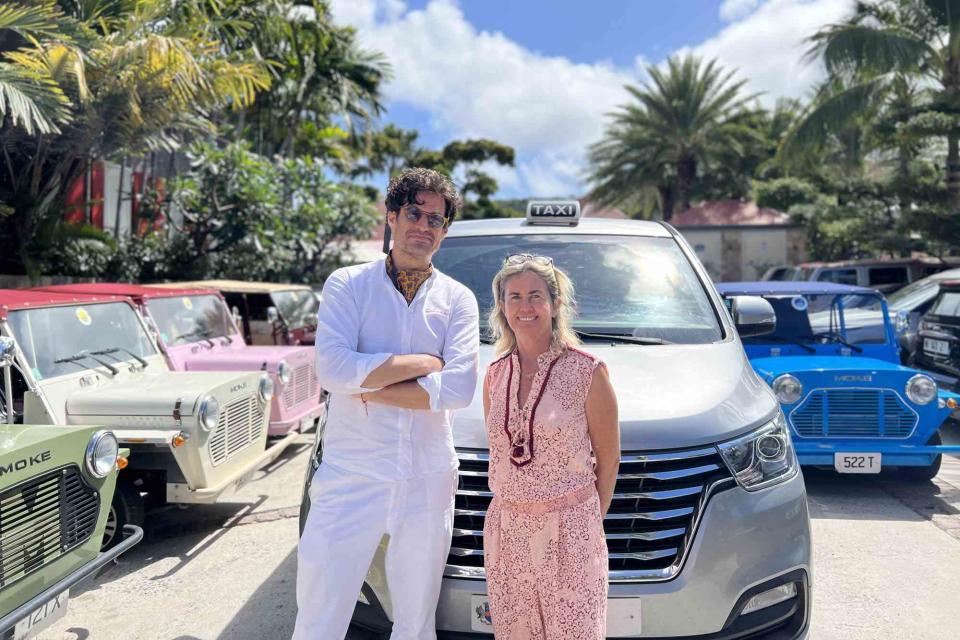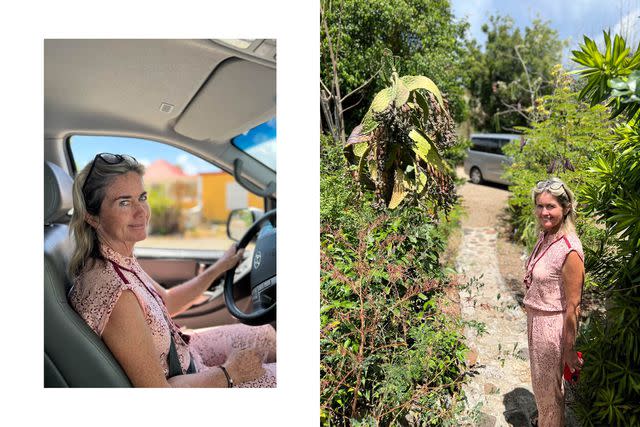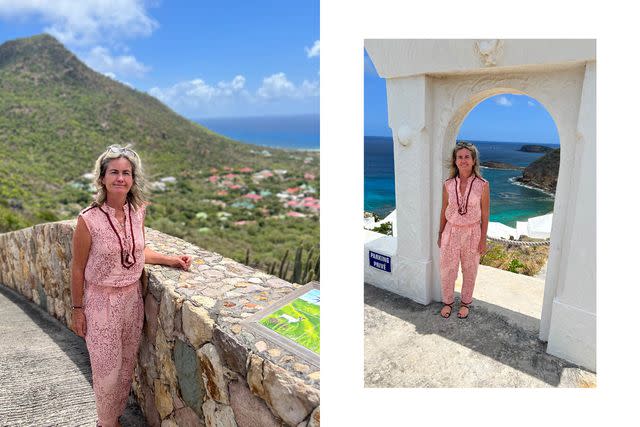This Caribbean Island's Vice President Will Give You a 1-on-1 Tour in Her Taxi — and I Took Her Up on It
A behind-the-scenes look at the famously chic St. Barts, with preservationist politician Hélène Bernier.

Courtesy of Tiffan Borelli
On a recent morning at Eden Rock - St Barths resort, I swept through the sceney Sand Bar restaurant and down the property's front steps to find my taxi. This was not to be a run-of-the-mill cab ride, though, because my driver was none other than Hélène Bernier, the vice president of Saint Barthélemy. Behind the wheel of her gray Hyundai H-1 van, dressed in a pink jumpsuit from the local Poupette boutique and her hand at her brow to block the sunlight, the flaxen-haired, 48-year-old politician greeted me as I hopped in shotgun.
In this tony French collectivity – a common Caribbean escape for Hollywood A-listers, Silicon Valley moguls, and European business magnates – I wanted an off-the-beaten-path journey, and certainly something beyond the island’s see-and-be-seen elements. The true draw of St. Barts, after all, is its well-preserved natural beauty, something that’s been threatened in no small measure amid the past few decades of rapid development. Bernier, who grew up here in a family of French ancestry that’s been on the island since 1648, is the island’s main conservationist and its consummate tour guide. Those two métiers arose in tandem: her time as a kids’ programming director at Le Guanahani, now a Rosewood hotel, and as a sailboat skipper, inspired her to create a nature-forward guide service for tourists called Easy Time back in 2005. (She officially got her taxi license in 2018.) Her commitment to showing others the island’s authentic local corners and rich biodiversity spurred her to found St. Barth Essential (SBE) in 2009, an environment protection group with the mission to “preserve the real St. Barts.”
"The real St. Barts" is just what she aims to explore with the travelers who book her taxi tours. It’s not so common a proposition, of course, to arrive at a place and have extended access to an elected official, let alone its second-in-command. But it’s an exhilarating opportunity any visitor to St. Barts can have, so I buckled up accordingly. In a fluster of franglais, we set out from the island’s social nexus to get an insider’s glance at the gem of the French West Indies, including its environmental beauties and vulnerabilities.

Ross Kenneth Urken/Travel+Leisure
“On y va!” she chirped, as she floored it onto the main drag. First, we headed up a curved escarpment to reach a point overlooking Colombier, a secluded beach at the island’s northwest tip that’s widely considered among the most attractive in the Caribbean; Prussian-blue and cyan waters shimmered below. It is here, she told me, that David Rockefeller acquired a 130-acre property in 1957 to build a waterfront villa she called his “Camelot,” which had sold just days before our meeting for $136 million. She elaborated on the rise of St. Barts as a jet-setters’ paradise for the likes of Greta Garbo and Howard Hughes. Times were simpler before, she said; with professorial cadence, she then ran me through a historical overview of the island, from the time of the native Arawaks and Caribs to pirate lore, the 100 years of Swedish rule, and the current French control. She believes it’s important to tell and preserve the story of the island and its natural environment. “If we don’t,” she said, gripping the steering wheel, “it’s easy to forget where we come from.”
That ethos has motivated her in further protecting the island through politics, first as a member of the Conseil Territorial, the island’s parliament. Then when Bruno Magras – an airline magnate who served in various St. Barts political positions for 27 years – decided not to seek reelection in 2022, she ran a successful campaign as a staunch environmentalist that landed her in the VP seat, with Xavier Lédée assuming the role of president.
Though some 60 percent of St. Barts is officially protected as green zones, it has been said that the real green that matters here is the American dollar. That is, the more you pay, the more you’re able to subvert the laws – something that was common under the Magras regime, with 1 percenters paying to bend the rules and build their villas in otherwise unauthorized areas. “With us, I don’t think that’s going to happen,” Bernier said.
As we zoomed south past the red roofs of Gustavia, the capital, Bernier shared how she shut down the efforts of hotelier Denise Dupré, wife of billionaire and former Domino’s CEO Mark Nunnelly. Her company, SAS Saint Jean Beach Real Estate, planned to spend $170 million to build its second St. Barts hotel on the posh but environmentally vulnerable St. Jean Beach. By contrast, Bernier is encouraging of efforts from neighboring Eden Rock, which instead intends to rehabilitate the St. Jean Pond and support St. Jean Bay coral restoration.
As Bernier revved around collywobbles-inducing curves, she casually suggested we stop by the Gouverneur beach estate that Roman Abramovich had bought for $90 million in 2009. She called up Jim Boos, the Russian oligarch’s longtime right-hand man, who answered and informed her he was in Mississippi and couldn’t let us in for a peek. Instead, we made our way toward Grand Saline on the south coast and pulled over at the salt pond here that once contributed to a thriving salt export business until the 1970s. Rapid development during the second half of the 20th century polluted these waters. In 2009, she managed to prevent André Balazs from building a beachfront hotel here, but three rock-crushing sites nearby have only exacerbated the health of this ecosystem. She pointed out a sole black-necked stilt, one of the island’s 13 protected birds, strutting in the shallows.

Ross Kenneth Urken/Travel+Leisure
Overlooking the pond sits a gray house that once belonged to Charles Dumont, who co-wrote love ballads with Edith Piaf. There’s still some hope here, Bernier said. The area is being restored thanks to efforts from the likes of the Make Saint-Barts Green Again association. She has plans to build a little museum to tell the story of salt exports on the island and honor the heritage of this site while also cleaning it up enough to make and sell salt from this culturally important location.
At our next stop, a panoramic viewpoint of Grand Fond, she pulled the parking brake with a cartoonish ratchet sound and hopped out to survey the lesser-developed valley of her youth between Morne Vitet, the island’s highest point, and Morne de Grand Fond peak. Candle cactuses rose before us, and she assumed an everything-the-light-touches vibe, à la Mufasa, as she spoke about the land below. Her blue eyes became a little teary as she recalled her idyllic childhood here in the '70s; with electricity but no plumbing, she showered from a bucket filled with cistern-warmed water. In the distance, she pointed to the famous Washing Machine, a spot where the ocean crashes against the rocky cliffs such that it eddies like a natural spin cycle.
Descending a steep road and into a little neighborhood where many of her cousins still live in cases creoles (traditional cottages), we passed her grandparents’ yellow house where she mostly grew up — framed by saffron almendra flowers, latanier palms, bougainvillea, and oleander. Down the way, we stopped in to see her three-year-old twin girls, who were under the weather and spending the day at the home of Nancy, her ex-wife, with whom she co-parents. Bernier and I walked out to the back deck, and beyond the brown cows in front us, we looked to the ocean to try to spot any whale flukes. It was prime season to see humpbacks, and as an avid scuba diver, Bernier said she enjoys hearing their song underwater. They come to mate in the warm Caribbean waters, and the mothers typically give birth toward the Dominican Republic before returning with their calves off the coast of St. Barts. For Bernier, this maternal bond reinforces the importance of her environmental initiatives on the island and its surrounding marine environment. “It’s important, what you leave to your children,” she said. “I try to preserve the land my father gave me and try to give it to my children.”
Continuing our route around the island, we drove along the corniche toward Toiny Beach. Through the passenger-side window: poached-egg sea foam on the sand, itself baked the color of a crêpe Suzette. The severe southeast coast here is gorgeous in its craggy rawness — known as an ideal spot to glimpse egrets, herons, and gannets. She pointed to a house where the Russian ballet dancer Rudolf Nureyev used to live. It’s now a villa that Le Toiny, a glamorous five-star hotel, books out. Growing up, Bernier used to see Nureyev dancing on the deck, turning arabesques and fouettés against the backdrop of the ocean.
We next stopped at the lagoon at Grand Cul-de-Sac on the northwest side of the island, where she went to the beach as a child. The bay is full of yachts whose names, like Gallant Lady, could double as those of Triple Crown–winning stallions. She reflected on how the once-pristine slice of St. Barts has changed.
“It was not like this…” she said. “The water was bluer. And we had a lot of trees everywhere. No boats.” She said that it’s not irrevocably unhealthy, but that enhanced policies need to ensure development doesn’t further imperil this precarious spot.
On an island as small as St. Barts — with 10,000 residents on 9.7 square miles — people have a tendency to inform her when someone runs afoul of conservation policy. Once, someone reported a developer who was bulldozing mangroves. She had him stopped, and he promised to kill her. It wasn’t her first death threat, and it likely won’t be her last. There have been multiple bribe attempts, too. But Bernier is unwilling to let people take advantage of the natural environment on this island. Not on her watch.
In the area, there are some bright notes. The cove off Rosewood Le Guanahani is filled with rays and has seagrass beds that support a large population of endangered green sea turtles, whose heads pop out of the water like periscopes. The property itself features the rare Turks cap cactus, which provides a supportive environment for tortoises, lizards, and tree frogs. An elevated hiking trail flaunts an array of local fauna. She once minded the kids on this property. Now, she’s looking after the future of the entire island.
Bernier lives just nearby, and we popped back in the taxi and drove to her home. In her yard, a moringa tree stands adjacent to a desert rose. She put her hand on the hipswell of a gaiac tree, a species protected by ministerial decree, and pointed out her 125cc Sym motor bike, her main mode of transportation when not leading tours. This is her sanctuary — though one that still attracts some conflict, too. People come with million-dollar offers to buy her land. “Sometimes it’s difficult to say no,” she said.
Her cousin was cleaning her house; laundry sat folded on the bed, a dream catcher floated on the wall by the staircase landing. Magnets fastened two $2 bills to the stainless-steel fridge, along with drawings by her kids and a take-out menu from a local food delivery service. She’ll often bring the tourists she guides to her house. “Depends if they are nice!” she said, flashing a smile. “I like to the tell the history of the island, and I am a part of that history.”
As we drove back toward Eden Rock — by way of the north coast’s Pointe Milou – we passed Le Ti St Barth, which has a dinner cabaret show and costume party for guests that she highly recommends. At an intersection, a tourist on a motorbike, oblivious to the fact that she was addressing the island’s vice president, asked for directions. Bernier set her on the right path. We soon passed a construction crane for a villa. Bernier said she doesn’t think St. Barts needs any more hotels, and believes development needs to slow. “If we build, build, build more, the tourists who have come for many years aren’t going to come any more,” she said. “Because the charm of St. Barts is because it’s preserved."
At Eden Rock, she pulled the parking brake hard. It was time for her to get to her government office in Gustavia and me to get back to the Sand Bar.
You can book a tour with St. Barts' vice president Hélène Bernier via WhatsApp (contact +590 690 634609) or this website. Prices start at $112 an hour but vary depending on group size and type of tour.
For more Travel & Leisure news, make sure to sign up for our newsletter!
Read the original article on Travel & Leisure.

